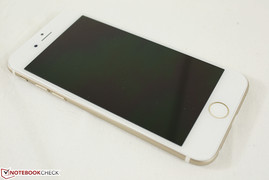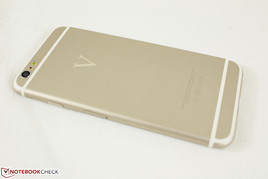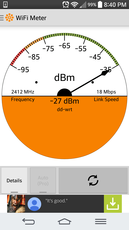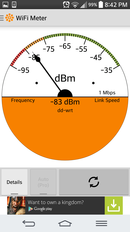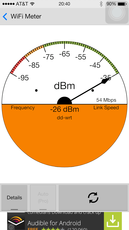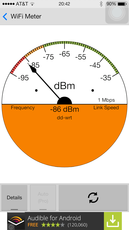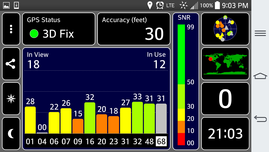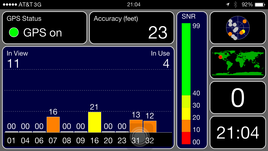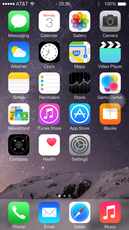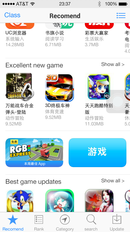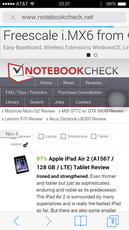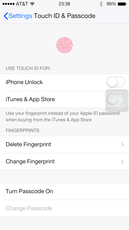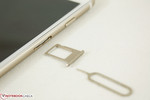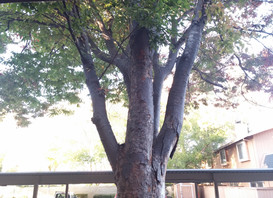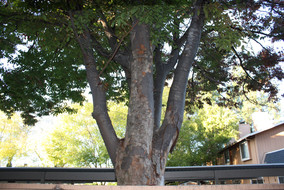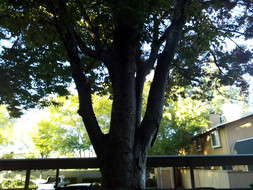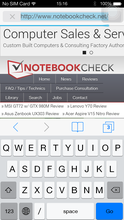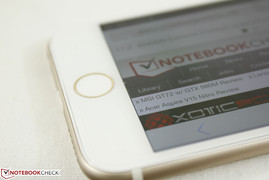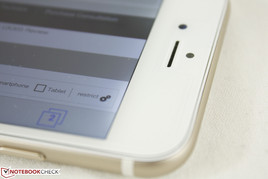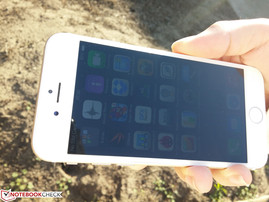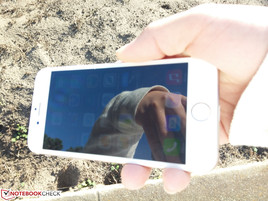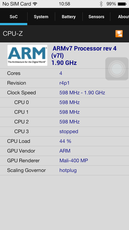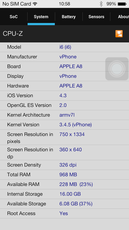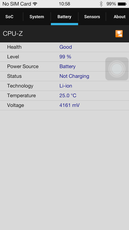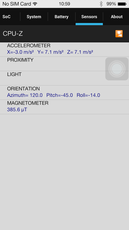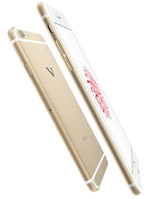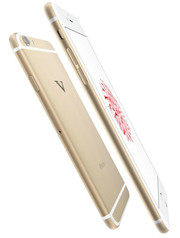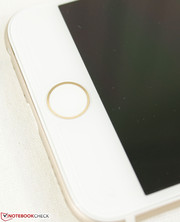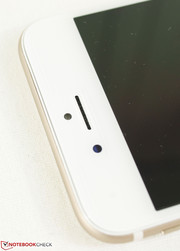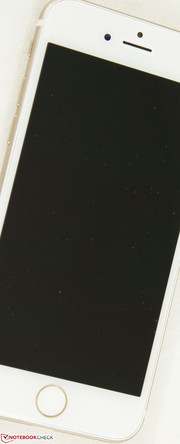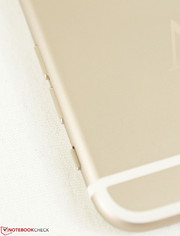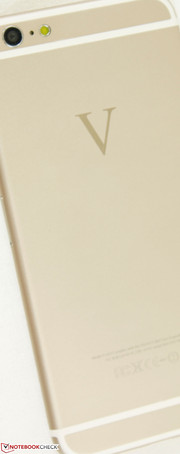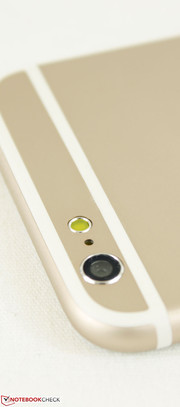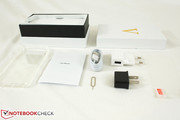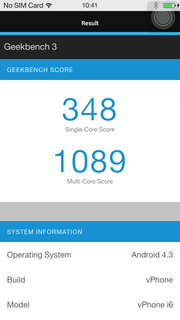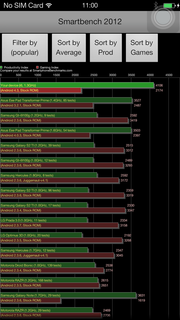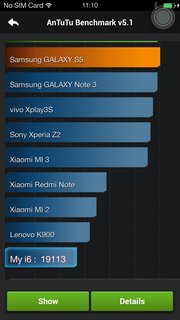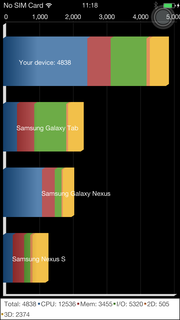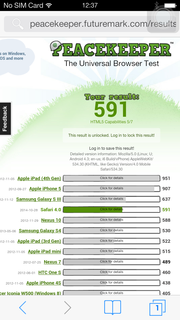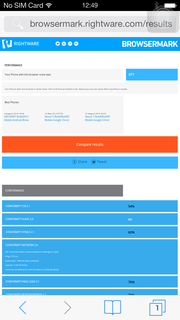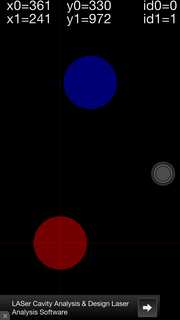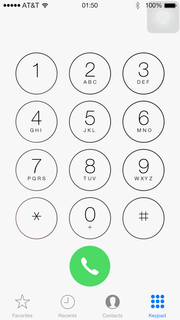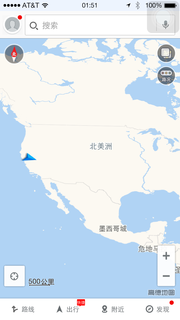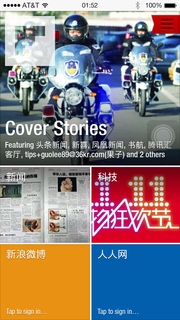No. 1 Vphone I6 Smartphone Review

iPhone clones aren't new, but the recent rise in quality of inexpensive Chinese smartphones has been making bigger and bigger footprints in the smartphone world to the point where major manufacturers are beginning to feel the impact. Sony, for example, announced their ambitious goal in 2013 to be the world's third largest smartphone manufacturer, but sales have been steadily declining in the Asian market due largely to much more inexpensive alternatives.
The Vphone I6 is the latest example of an inexpensive Chinese smartphone with some serious quality features for the price. Comparisons against the iPhone 6 are inevitable yet unfair considering the near tenfold price difference between the two devices. For less than $150 USD, however, users are getting an admittedly beautiful 720p IPS screen, a mainstream Mediatek MT6582 quad-core SoC, and an almost perfect reproduction of the new Apple chassis.
The hardware on paper looks like a steal for the price, but how does the software fare? We check out what the Vphone I6 has to offer in this review and compare its performance against other entry-level smartphones including the Snapdragon-powered Sony Xperia M2, similarly equipped LG L Bello, and the older Tegra 3-powered HTC One X+.
Before we begin, let's get some of the major hardware differences between the Vphone and iPhone 6 out of the way:
| Model | No. 1 Vphone I6 | Apple iPhone 6 |
| Screen | 4.7-inch IPS, 1280 x 720, 312 PPI, plastic front | 4.7-inch IPS, 1334 x 750, 326 PPI, oleophobic glass front |
| Processor | 1.3 GHz quad-core Mediatek MT6582 | 1.4 GHz dual-core ARMv8-A |
| Graphics | ARM Mali-400 MP2 | PowerVR Series 6 GX6450 |
| Touchscreen | 2-finger capacitive | 10-finger capacitive |
| Wireless Communication and Sensors | 802.11 b/g/n, GPS, Bluetooth, Accelerometer, Magnetometer, Gyroscope | 802.11 a/b/g/n/ac, GPS, Bluetooth, Accelerometer, Magnetometer, GLONASS, NFC, Gyroscope, Proximity and Ambient light sensors, Barometer, Fingerprint reader |
| Cameras | Rear: 16 MP, Front: 5 MP | Rear: 8 MP, Front: 1.2 MP |
| Maximum Display Brightness | 144 cd/m² | 529 cd/m² |
| Measured Contrast | 320:1 | 850:1 |
| Battery | 1600 mAh | 1810 mAh |
| WLAN Battery Life | 163 minutes | 530 minutes |
| Operating System | Android 4.3 (w/ iOS skin) | iOS 8/ 8.1 |
| U.S. price | $149 | $799 |
Case
The company No. 1 have successfully reproduced the chassis of the iPhone 6 both visually and physically. Simply put, this looks and feels like an iPhone 6 and that in itself is an achievement for such a low asking price. One would be able to hand this phone to an Apple fanatic and he or she would be fooled - at least at first glance.
Eagle-eyed Apple users will be quick to point out a few dead giveaways on this iPhone clone aside from the obvious "V" imprint on the back. Firstly, the rear camera on the Vphone protrudes less than on the iPhone 6 and the chrome around the circumference of the adjacent flash module appears slightly thicker. Secondly, the display itself lacks any glass protection and uses hard plastic in its place. Applying moderate pressure on the Vphone display, for example, will cause a rainbow of colors while the iPhone 6 holds steady under the same circumstances. Thirdly, the Thunderbolt slot is a rather soft white plastic on the Vphone instead of a chrome metal perimeter.
These minor differences are so easily overlooked, however, that the design can essentially be considered a 1:1 reproduction. Even the weight of the two devices is a match at 129 grams each. The phone can be twisted ever so slightly with enough force, but this is again a minor setback. Our comments, comparisons and criticisms of the iPhone 6 chassis all apply here and budget models just don't stand a chance against the Vphone in terms of visual appeal.
Connectivity
Physical ports do not go beyond the Thunderbolt and 3.5 mm audio jacks. Thus, it suffers from the same criticism as the iPhone 6 where the more ubiquitous microUSB cables are incompatible for charging and file transfers. Furthermore, first-party Apple adapters are not guaranteed to work on the Vphone.
Communication & GPS
WLAN is compatible with 802.11b/g/n networks and we experienced no random drops or connectivity issues with a Linksys home router. HD Youtube videos, for example, stream without hiccups or problems. Bluetooth works flawlessly as well as connecting to Bluetooth-enabled headphones and other devices proved to be painless. The WLAN radio range is slightly below the LG G2 as the Vphone loses connection a few meters shorter when almost 40 meters away from our WLAN source according to WiFi Signal Strength. Otherwise, signal strength is similar to the LG up until the point of disconnection.
The integrated GPS is weak and a bit slow, even with ISP support. Allowing five minutes outdoors to acquire satellites only resulted in 11 in view, while our LG G2 was able to locate much more according to GPS Test. Fixed satellites would also occasionally drop. This makes GPS more unreliable than it should be as it will be more likely lose signal during use and take longer to reacquire a location fix.
Software
Faithfully emulating iOS and all its perks onto Android is easier said than done. The Vphone may look the part, but its software has a number of disappointments.
The Home screen and Settings menus look as they appear on the Apple equivalent, but dig deeper and more oddities begin to surface. Many pre-installed apps, for example, are Chinese only, and the Chinese App Store suffers from occasional bugs and crashes. The Maps app has a difficult time locating our coordinates, and the Youtube app from the Chinese App Store fails to launch. The Safari browser feels slow to load despite respectable connection speeds according to Speed Test. Additionally, some features do not work as originally advertised. The Fingerprint ID unlock, for example, will unlock with any finger from any user, making it essentially worthless. Attempting to use iCloud will generate a message stating that the service is not supported on the Safari browser.
Most app limitations stated above can be circumvented by installing your own apps from the Play market as many Android apps will install and run successfully. In the end, Vphone users should not expect to be using the exact same apps or software features that iPhone users have been accustomed to.
On the plus side, local music and video files play well on their respective apps. Transferred MP3 and FLAC files are quickly recognized and supported video extensions include MOV and 3GP. Our tested Big Buck Bunny 1080p videos play smoothly in full screen. Other tested video files, including AVI and MKV, will either play with no audio or not be recognized at all.
Telephone & Speech Quality
Connection to AT&T towers is as good as any other AT&T device with no abnormalities specific to the VPhone. Note, however, that the Vphone supports up to 3G only with no support for HSPA+ or LTE, at least in the United States. This is common amongst Chinese phones as they often lack compatible FDD radios for 4G connectivity. CDMA users are out of luck here as well, so Sprint users in particular will not be able to use this phone with their network. This is certainly not a phone for heavy data users.
Call quality is average at best due to static and voices being more high-pitched than normal. Though maximum volume is loud enough for noisier environments, the higher volume causes additional static. The person on the other end had a much easier time listening and reported no dropped instances during calls.
Cameras
The 16 MP (4096 x 3072) rear and 5 MP (2560 x 1920) front cameras look good on paper as these are certainly high megapixel counts on such an inexpensive phone. With that said, the camera app lacks many common features including ISO, brightness, white balance, and image size settings. Filters, HDR and panorama. The camera flash is useful as a recording indicator or small flashlight only.
Picture quality is muddier than what one would expect from a 16 MP camera. Fortunately, colors are good and there is little evidence of purple fringing, which is a more common problem on budget low MP cameras. Noise is at a relative minimum assuming sufficient ambient lighting and darker shots will almost always be blurrier on the Vphone due to the slower shutter speed under such circumstances. Pictures are saved quickly for users to take fast shots about one second apart. Overall quality under bright outdoor conditions is acceptable for the price.
Similarly, videos suffer from the same problems as the camera and are limited to 720p only.
Accessories
The Vphone comes with a bit more extras than what one would normally expect from smartphones. This includes an AC wall charger, UK charger adapter, 2x Thunderbolt cables, 2x screen protectors, and a clear protective case. There are unfortunately no earbuds, but what is included is already above average.
Warranty
1949deal offers the standard 12 month warranty for the Vphone and covers defective units or missing items. Buyers are expected to pay for return shipping, which may or may not be costly as the package must be returned to China for repairs. Additional information on the retailer's warranty can be found here.
Input Devices
Touchscreen
The capacitive touchscreen is not consistently reliable. While it works well when inputting commands slowly, fast touch-typists will find that the long onscreen delay will frequently cause the smartphone to not register inputs. For example, the Vphone will often miss more letters than usual when typing SMS messages or inputting URLs quickly, but will otherwise respond reliably when navigating through the homescreen and Settings. A spell checker option is available, but there is no default Swype support.
Another oddity of the touchscreen is that it is less reliable around the corners and edges. Pressing the Back and Tabs buttons on the Safari browser, for example, will often take multiple touches as the phone may not register the first tap.
Pinch-to-zoom is supported, but it again feels slow in both performance and responsiveness. Furthermore, the screen will only recognize up to two fingers simultaneously, so users will not be able to customize any three-finger gestures such as those on the LG G2 or G3.
Display
The 4.7-inch display offers the increasingly common native resolution of 720p for a pixel density of 312 DPI. This is very close to - and nigh indiscernible from at first glance - the 326 DPI screen on the iPhone 6. Text and colors are sharp and clean and the screen even rivals a handful of smartphones that retail for much more than the Vphone. Furthermore, the IPS panel provides more consistent colors that are not unlike more well-known models that the Vphone is attempting to emulate.
Dig a little deeper, however, and the cut corners begin to reveal themselves. For one, maximum brightness has been reduced from 500+ nits on the original iPhone 6 to just ~140 nits. This makes the Vphone satisfactory for indoor use, but extremely difficult for comfortable use outdoors. In fact, this brightness level is drastically low compared to most smartphones in the market, including the inexpensive Xperia E1. Secondly, measured contrast is roughly 300:1, which is nearly one-third of not just the iPhone 6 but also cheaper devices like the LG L Bello and Acer Liquid E700 Trio. Despite this, movies and images still look good since the screen is so sharp with colors that seem to pop.
| |||||||||||||||||||||||||
Brightness Distribution: 89 %
Center on Battery: 141.9 cd/m²
Contrast: 320:1 (Black: 0.443 cd/m²)
ΔE ColorChecker Calman: 7.6 | ∀{0.5-29.43 Ø4.77}
ΔE Greyscale Calman: 7.5 | ∀{0.09-98 Ø5}
Gamma: 2.24
CCT: 8549 K
| No. 1 Vphone I6 Mali-400 MP2, MT6582, 16 GB SSD | HTC One Mini 2 Adreno 305, 400 MSM8226, 16 GB iNAND Flash | Sony Xperia E1 Adreno 302, 200 8210, 4 GB Flash | LG L Bello Mali-400 MP, MT6582, 8 GB SSD | HTC One X+ GeForce ULP (Tegra 3), 3, 64 GB SSD | Apple iPhone 6 PowerVR GX6450, A8, 128 GB eMMC Flash | |
|---|---|---|---|---|---|---|
| Screen | 81% | 59% | 84% | 106% | 108% | |
| Brightness middle (cd/m²) | 141.9 | 444 213% | 348 145% | 421 197% | 392 176% | 520 266% |
| Brightness (cd/m²) | 138 | 439 218% | 358 159% | 411 198% | 387 180% | 511 270% |
| Brightness Distribution (%) | 89 | 94 6% | 92 3% | 94 6% | 91 2% | 88 -1% |
| Black Level * (cd/m²) | 0.443 | 0.57 -29% | 0.51 -15% | 0.5 -13% | 0.45 -2% | 0.61 -38% |
| Contrast (:1) | 320 | 779 143% | 682 113% | 842 163% | 871 172% | 852 166% |
| Colorchecker dE 2000 * | 7.6 | 6.59 13% | 6.43 15% | 6.75 11% | 3.92 48% | |
| Greyscale dE 2000 * | 7.5 | 7.14 5% | 7.92 -6% | 5.63 25% | 4.33 42% | |
| Gamma | 2.24 98% | 2.48 89% | 2.52 87% | 2.12 104% | 2.46 89% | |
| CCT | 8549 76% | 8636 75% | 9560 68% | 7472 87% | 7384 88% |
* ... smaller is better
Lastly, the screen suffers from moderate backlight bleeding on the edge closest to the earpiece. This is noticeable during everyday tasks like browsing and email and can become even more pronounced depending on the viewing angle. It's not a showstopper, but picky users may find the effect distracting.
Color analyses with an X-Rite spectrophotometer reveal relatively poor grayscale and an average RGB balance against the sRGB standard. Color reproduction across varying saturation levels is good and similar to the LG L Bello and HTC One Mini 2. The primary colors are generally accurate, especially Green, but Teal is far and away the least accurate with a DeltaE deviation of 10 units or more across the board.
Though the Vphone impresses with its color reproduction for the price, precise colors are relatively unimportant on smartphones where brightness and contrast reign supreme. This is where the weakness of the Vphone becomes clear as day as outdoor usability is very difficult. Unless if the time of day is dusk or dawn or the middle of the night, the backlight will not be sufficiently powerful to overcome both glare from the glossy screen and ambient light from the sky or Sun. It can still be quite difficult to view the screen comfortably even in more brightly lit indoor environments like shopping malls or classrooms. Expect to be at the maximum brightness setting everyday.
Performance
The Mediatek MT6582 SoC is designed for entry-level to mainstream smartphones and can be found in a small number of budget devices including the LG L Bello, Liquid E700, and Ascend G730. The quad-core chip operates at a base clock of 1.3 GHz in the Vphone, but will dynamically clock down to 600 MHz to conserve power. When combined with its dual-core Mali-400 MP2 integrated graphics, overall performance is somewhat similar to the Tegra 3 APU that was common in mainstream smartphones of 2012.
The synthetic benchmarks below show that the Vphone performs as expected from a smartphone in its price range. Geekbench, Linpack, and AndEBench all place the Mediatek MT6582 in the same ballpark as the Snapdragon 400 MSM8926 and Tegra 3. In other words, this may look like an $800 smartphone, but it still performs like a smartphone that is a fraction of the cost.
Note that the Quadrant and Smartbench benchmarks, which score devices on overall performance instead of raw CPU power, show the Vphone lagging behind its competitors by an appreciable margin. And as another extreme example of the power gap between the Vphone and iPhone 6, Linpack shows that the Mediatek MT6582 is at least 8x slower than the Apple A8 in raw single-threaded operations.
| Geekbench 3 | |
| 32 Bit Multi-Core Score (sort by value) | |
| No. 1 Vphone I6 | |
| Sony Xperia M2 | |
| HTC One Mini 2 | |
| Sony Xperia E1 | |
| LG L Bello | |
| Apple iPhone 6 | |
| Acer Liquid Z4 | |
| 32 Bit Single-Core Score (sort by value) | |
| No. 1 Vphone I6 | |
| Sony Xperia M2 | |
| HTC One Mini 2 | |
| Sony Xperia E1 | |
| LG L Bello | |
| Apple iPhone 6 | |
| Acer Liquid Z4 | |
| Linpack Android / IOS | |
| Multi Thread (sort by value) | |
| No. 1 Vphone I6 | |
| Sony Xperia M2 | |
| HTC One Mini 2 | |
| Apple iPhone 6 | |
| HTC One X+ | |
| Single Thread (sort by value) | |
| No. 1 Vphone I6 | |
| Sony Xperia M2 | |
| HTC One Mini 2 | |
| Apple iPhone 6 | |
| HTC One X+ | |
| Smartbench 2012 | |
| Gaming Index (sort by value) | |
| No. 1 Vphone I6 | |
| Sony Xperia M2 | |
| HTC One Mini 2 | |
| HTC One X+ | |
| Productivity Index (sort by value) | |
| No. 1 Vphone I6 | |
| Sony Xperia M2 | |
| HTC One Mini 2 | |
| HTC One X+ | |
| AnTuTu v5 - Total Score (sort by value) | |
| No. 1 Vphone I6 | |
| Apple iPhone 6 | |
| AndEBench | |
| Java (sort by value) | |
| No. 1 Vphone I6 | |
| Sony Xperia M2 | |
| HTC One Mini 2 | |
| Native (sort by value) | |
| No. 1 Vphone I6 | |
| Sony Xperia M2 | |
| HTC One Mini 2 | |
| Quadrant Standard Edition 2.0 - --- (sort by value) | |
| No. 1 Vphone I6 | |
| Sony Xperia M2 | |
| HTC One Mini 2 | |
| HTC One X+ | |
| Vellamo 3.x | |
| Metal (sort by value) | |
| No. 1 Vphone I6 | |
| Sony Xperia M2 | |
| Multicore Beta (sort by value) | |
| No. 1 Vphone I6 | |
| Sony Xperia M2 | |
| Browser (sort by value) | |
| No. 1 Vphone I6 | |
| Sony Xperia M2 | |
System Performance
Subjectively, day-to-day performance is average. Launching applications and returning to the Home screen are not instantaneous actions as it can take up to a couple of seconds before anything happens onscreen. Frame rates are stable if there is minimal background activity, but they can become frequently erratic once more applications are running simultaneously. Though this is to be expected from budget devices, these hiccups do feel as if they happen more often on the Vphone.
Perhaps the biggest bottleneck in performance is the touchscreen itself, which is less accurate and responsive than other budget models. We found ourselves double-tapping on icons, links, and other onscreen buttons far too often.
| WebXPRT 2013 - Overall (sort by value) | |
| No. 1 Vphone I6 | |
| Sony Xperia M2 | |
| HTC One Mini 2 | |
| Sony Xperia E1 | |
| Apple iPhone 6 | |
| Sunspider - 1.0 Total Score (sort by value) | |
| No. 1 Vphone I6 | |
| Sony Xperia M2 | |
| HTC One Mini 2 | |
| Sony Xperia E1 | |
| LG L Bello | |
| Apple iPhone 6 | |
| Acer Liquid Z4 | |
| Mozilla Kraken 1.1 - Total (sort by value) | |
| No. 1 Vphone I6 | |
| Sony Xperia M2 | |
| HTC One Mini 2 | |
| Sony Xperia E1 | |
| LG L Bello | |
| Apple iPhone 6 | |
| Google V8 Ver. 7 - Google V8 Ver. 7 Score (sort by value) | |
| No. 1 Vphone I6 | |
| Sony Xperia M2 | |
| Apple iPhone 6 | |
| Acer Liquid Z4 | |
| HTC One X+ | |
| Peacekeeper - --- (sort by value) | |
| No. 1 Vphone I6 | |
| Sony Xperia M2 | |
| HTC One Mini 2 | |
| Sony Xperia E1 | |
| Apple iPhone 6 | |
| HTC One X+ | |
| Browsermark - 2.1 (sort by value) | |
| No. 1 Vphone I6 | |
| Sony Xperia M2 | |
| HTC One Mini 2 | |
| Apple iPhone 6 | |
* ... smaller is better
Storage Devices
Like the least expensive iPhone 6 model, the Vphone includes a 16 GB internal SSD with no external storage options.
When connected to a desktop, the Vphone is displayed as two independent removable drives of 5.38 GB and 7.39 GB. Furthermore, only about half of each drive is immediately available for use after taking into account pre-installed software and system files. This leaves a little less than 10 GB of free space for the user. While this is sufficient for a small selection of music and videos, users will have to rely on cloud storage for additional space.
Outside of the small size, SSD performance according to Androbench is on par with competing budget smartphones. Most notably, random write of small 4 KB blocks is faster than most other budget offerings, though sequential write speeds could have been better.
Games
The integrated Mali-400 MP2 GPU in the Vphone outputs a graphics score of 2680 points in 3DMark Ice Storm, which is similar to smartphones with the older SGX544 GPU like the QV830 and One Touch Idol X. Thus, side-scrollers and moderately heavy 3D games will play without frame skips. More intensive 3D titles are not likely to perform very well as even the Ice Storm benchmark runs at only 15 to 20 FPS. Most 3D titles in the Chinese app store are also simple in textures and geometry, so complicated 3D titles are very few and far between.
| 3DMark Ice Storm Standard Score | 3146 points | |
Help | ||
Emissions
Temperature
Surface temperatures are cool at well below 30 degrees C on average on both the front and back of the device. Similar to the iPhone 6, areas that are closer to the rear camera will become much warmer than on the other end of the device. The gradient, however, is much lower and flatter here due to the less demanding Mediatek SoC. Also note that the front of the device is generally warmer than the back when under system stress, so the user can more comfortably hold the phone on his or her palm no matter the processor load.
Our maximum load measurements were measured after running StabilityTest for over an hour. Thus, users are unlikely to encounter our measured surface temperature of almost 40 degrees C under everyday use. The Liquid E700, which houses the same Mediatek MT6582 SoC, can also reach surface temperatures of 40 degrees C despite its larger 5-inch display.
(±) The maximum temperature on the upper side is 40.8 °C / 105 F, compared to the average of 35.2 °C / 95 F, ranging from 21.9 to 247 °C for the class Smartphone.
(+) The bottom heats up to a maximum of 35 °C / 95 F, compared to the average of 34 °C / 93 F
(+) In idle usage, the average temperature for the upper side is 27.5 °C / 82 F, compared to the device average of 32.9 °C / 91 F.
Speakers
Sounds emanate from the same six holes on the bottom edge of the phone, but quality is average. Music and voices are high-pitched with almost no bass and a narrow range. Some slight residual noise can be heard when at maximum volume as well, which further reduces quality. The internal monaural speaker is sufficiently loud for speakerphone or casual use, but 3.5 mm earbuds are recommended for movies and music.
Battery Life
The Vphone includes a non-removable 1600 mAh battery. This is relatively small as the iPhone 6 uses a higher capacity 1810 mAh battery pack and smaller budget smartphones like the 4.3-inch Galaxy Ace 4 can house 1900 mAh battery packs. The inexpensive 4.7-inch Desire 510 uses an even higher capacity 2100 mAh battery.
Overall runtimes are poor. If sitting completely idle on the home screen at minimum brightness and with all wireless radios disabled, the Vphone will last a bit over 6 hours. These ideal conditions are not representative of actual use, so we run our WLAN test that puts the display close to 150 nits while looping our standard browser script to simulating surfing. The smartphone lasts for a little over 2.5 hours under these conditions.
Compared to most smartphones in the market where idling and even WLAN runtimes often reach double digits, the 2.5 hours of constant use is disappointing. On the flip side, charging the Vphone is extremely fast at just under one hour from 10 percent to a full charge.
| No. 1 Vphone I6 Mali-400 MP2, MT6582, 16 GB SSD | HTC One Mini 2 Adreno 305, 400 MSM8226, 16 GB iNAND Flash | Sony Xperia E1 Adreno 302, 200 8210, 4 GB Flash | LG L Bello Mali-400 MP, MT6582, 8 GB SSD | HTC One X+ GeForce ULP (Tegra 3), 3, 64 GB SSD | Apple iPhone 6 PowerVR GX6450, A8, 128 GB eMMC Flash | |
|---|---|---|---|---|---|---|
| Battery runtime | 161% | 175% | 182% | 184% | 168% | |
| Reader / Idle (h) | 6.2 | 20.8 235% | 20 223% | 22.8 268% | ||
| WiFi (h) | 2.7 | 9.1 237% | 8 196% | 8.7 222% | 11 307% | 8.8 226% |
| Load (h) | 1.9 | 2.1 11% | 4.8 153% | 4.6 142% | 2.3 21% | 2.1 11% |
Verdict
For just $150, the Vphone I6 represents good value for the price. Since it is physically modeled so well after one of the most affluent smartphones currently in the market, the feel, look, thinness, and design of the Vphone are beyond what other budget and entry-level smartphones can offer. The 720p IPS screen looks gorgeous for such an inexpensive phone and compatible HD videos play smoothly with no frame rate issues. In fact, it is one of the best displays we've seen on a smartphone this cheap. Text is easy to read and colors really pop, especially when compared to competing models where 800 x 480 and other sub 720p resolutions are common.
On the other side of the coin, these major advantages are balanced out by some unfortunately glaring issues. Display brightness is too low for comfortable use outdoors and battery life is too short for anything but light usage throughout the day. Furthermore, a handful of pre-installed software are prone to crashing and can be Chinese-only, such as Maps, iTunes, and the App Market. Some do not even function as intended, such as the fingerprint reader. The somewhat slow system performance and general latency in registering inputs are other crucial areas that the software should improve on for future iterations. These are essential basics that we believe every entry-level smartphone should be capable of.
Notably, the device can successfully install most Android apps since the iOS skin is really Android Jelly Bean underneath. In this case, compatibility is hit-or-miss with similar results to installing Android apps on a Kindle Fire tablet.
As for other nitpicks, the Vphone lacks NFC (and by extension Apple Pay), 4G capabilities in the U.S., oleophobic glass coating, and both proximity and light sensors. These features are mostly reserved for high-end or mainstream devices only, however, so their omission here should be unsurprising to buyers.
The Vphone I6 works best as a secondary or backup smartphone or even a phone for kids. We find the poor battery life the most limiting factor for use as a primary device, but for just $150 apiece and with a display this nice, it's hard to complain about much else.




